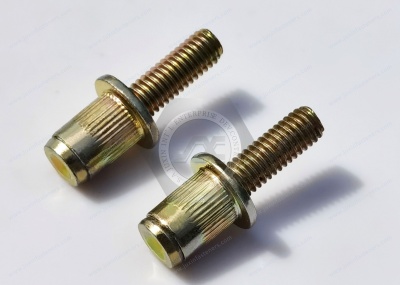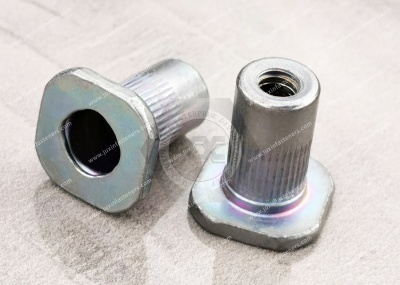Call Us
+86 136 6007 9809
Call Us
+86 136 6007 9809
Jan. 21, 2024
Rivet nuts in the new energy and photovoltaic industry in the application of industry solutions
A rivet nut is a mechanical connector commonly used in various fields, such as automotive, aerospace, and electronic equipment. It is used in many application scenarios and has many advantages, such as high strength, easy installation and disassembly, and reusability. The rivet nut is a threaded connector characterized by its ease of installation and compactness. It can be used in applications where disassembly is required. It has high tensile and torsional strength and can withstand high loads. It is widely used in engineering machinery, communication equipment, automobile parts, and other fields. Regarding photovoltaic modules, the rivet nut can be used as a connector for the mounting bracket, which can be fixed and supported.
The application of rivet nut in the field of new energy vehicles:Rivet nuts have essential applications in the automotive field. In automobile manufacturing, various metal parts must be connected, and the rivet nut can provide a reliable connection effect. For example, in the automobile chassis, rivet nuts are used to fix the body chassis to ensure the stability and safety of the body. In addition, in the automobile engine and suspension system, the rivet nut also plays an important role, ensuring that each component's connection is strong.
With the rapid popularization and development of new energy vehicles, rivet nuts, as a kind of compact structure and excellent performance connectors, are widely used in new energy vehicles, battery packs, electronic control systems, and other parts of the connection. The rivet nut not only ensures a firm and reliable connection but also effectively reduces the quality of the car, improves energy utilization, and reduces carbon emissions.
Rivet nuts in the solar energy field application solutions:Solar photovoltaic power generation is getting more and more attention as a clean and environmentally friendly form of new energy. In the manufacturing of solar panels, rivet nuts are used in the welding and fixing components. Rivet nut fittings for equipment in the photovoltaic industry have good anti-vibration properties. Due to weather changes, ground vibration, and other reasons, solar power equipment must have seismic solid capacity. Rivet nut fittings are usually made of high-strength materials and adopt unique thread design and fastening methods to ensure that the equipment will not be loosened or deformed under the vibration environment to ensure the stability and safety of the system.
In addition, rivet nut fittings for equipment in the photovoltaic industry are characterized by high precision and adjustability. The angle and position of the photovoltaic panels in the solar power generation system significantly impact the power generation efficiency. The high accuracy and adjustable performance of rivet nut fittings can ensure that the installation angle and position of photovoltaic panels can be precisely controlled, thus maximizing the efficiency of solar energy absorption.
In practical application, rivet nut fittings for PV industry equipment are widely used to install and fix solar photovoltaic modules, connect racking systems, and manage cables and other vital links. They ensure the safe and reliable operation of the equipment and provide a certain amount of adjustment space and convenience, making the installation and maintenance of photovoltaic equipment more efficient.
Pull rivet nuts can be used to tightly connect the cells of the panel with the radiator and other components through pre-loading technology, effectively solving the problems of cracking and aging of the weld joints that may occur in the traditional welding method and improving the service life and efficiency of the solar panels.
The development prospects and advantages of rivet nuts in the new energy industry:Rivet nuts have the advantages of simple structure, reliable connection, easy to install and dismantle, one-way operation, etc. The disadvantage is that most of the flange surface of the end of the riveted standard parts will protrude out of the plate, which is not conducive to the installation of the parts and the direct fit of the body plate. Rivet bolts and nuts are mainly used in aluminum alloy body profiles, castings, and thin-walled parts for the pipeline, wiring harness, trim accessories, and other critical mounting points to provide a mounting structure in the fastening connection to solve the problem of connecting different materials and to protect the painted or pre-treated surfaces, and also to avoid the welding of thin metal plates or thin metal tube welding nut is easy to melt, the substrate boards or tubes are easy to weld the deformation of the tapping threads are easy to slip teeth, etc., the development of riveting standard parts, the disadvantages of riveting common parts. The rivet nut was developed to avoid the disadvantages of welding thin metal sheets or tubes, such as melting the weld nut, deformation of the base material, and slipping the internal threads.
The rivet nut clamps firmly into the base material, resists vibration, and prevents joint loosening. In addition to providing internal threads, it allows for connecting various materials such as steel, stainless steel, aluminum, and plastic.
Highly corrosion-resistant coatings such as zinc-nickel are available. Lower cost, less hazardous, and less damaging to the substrate than welded nuts, and can be easily installed after painting to avoid clogging the threads. Even if painted before installation, the substrate will not be deformed, twisted, or damaged. Rivet nuts are particularly suitable for installing threads into closed areas where a blind surface cannot be reached. Rivet nuts perform both nut and rivet-loading functions.
With the rapid development of the new energy industry, rivet nuts' application areas will become increasingly extensive. Compared with the traditional welding connection, the rivet nut has the advantages of a solid connection, anti-vibration, anti-seismic, high temperature, durability, ease of installation, etc., which can meet the high requirements of new energy products on connectors.
At the same time, rivet nut also has the advantages of saving materials, reducing pollution, improving energy utilization, etc., which can help promote the sustainable development of the new energy industry.


Rivet nuts are used in aerospace applications:The aerospace field is widely used in the structure of airplanes, helicopters, spacecraft, aviation toilet brackets, salute racks, aviation seats, and other aircraft. As many places in the aircraft are difficult to operate due to space constraints, the rivet nut has the advantages of labor-saving, firmness, lightweight size, and so on, so it becomes an irreplaceable fastening element. Due to the unique working environment and high aircraft manufacturing requirements, the connectors' requirements are also more stringent. Rivet nuts have the characteristics of high strength, lightweight, etc., which can meet the requirements of aircraft. In the aircraft's wings, fuselage, and engine parts, rivet nuts are widely used to ensure the aircraft's structure is solid and safe to fly.
Rivet nut solution for communication and electrical equipment applications:A rivet nut for electrical grounding, comprising a head, a light bar portion, and a threaded portion with internal threads, said head having a spike on the side facing said light bar portion, said light bar portion being provided with a resilient sealing ring in contact with articulated head, said spike being embedded in said resilient sealing ring and protruding from said resilient sealing ring. The elastic sealing ring is set on the light pole part and is in contact with the head; when the rivet nut is assembled into the equipment, the elastic sealing ring undergoes compression deformation to realize the sealing between the head and the equipment, and it is not easy for moisture to pass through between the two. And because the cusp is embedded in the elastic sealing ring and protrudes from the elastic sealing ring set, the cusp can be stably riveted to the equipment shell to ensure a good grounding effect. In producing electronic equipment, we often need to fix the thin plate together and rivet nuts because of the convenience, speed, solidity, and other advantages, so it is widely used to manufacture electronic equipment. In laptop computers, tablet computers, cell phones, and other devices, many rivet nuts are used to manufacture and maintain electronic equipment, often needed to connect the metal casing, heat sinks, and other components. Pull rivet nuts can provide a reliable connection to ensure the stability and performance of the equipment. For example, rivet nuts are widely used to fix various connectors in computer mainframes, cell phones, tablet computers, and other electronic equipment.
Precautions for the use of rivet nuts on photovoltaic modules:
1. Select the appropriate rivet nut model. Different rivet nuts have additional load-bearing capacities, so choose the proper model according to the specific circumstances.
2. Pay attention to the thread direction and firmness when installing the rivet nut. Generally, use a wrench to tighten the rivet nut firmly to avoid loosening or loosening.
3. The service life of rivet nuts is limited; we should regularly check whether they are loose or thread wear, such as the emergence of problems and timely replacement.
Other details that need attention:
1. Before installation, carefully check whether the support frame of the PV module is damaged or deformed and if there are problems that need to be replaced or repaired in time.
2. After installation, An fA functional test should be conducted to confirm whether the support frame and rivet nut can firmly support the PV module.
3. Avoid excessive force or intense vibration during the use process to avoid damage to the rivet nut.
In addition to the above fields, rivet nuts can also play a role in many other fields, such as construction, machinery manufacturing, furniture manufacturing, etc. In construction, rivet nuts can be used to fix building structures, such as steel structures, aluminum alloy doors, and windows. In machinery manufacturing, rivet nuts can be used to improve various mechanical equipment and ensure the regular operation of mechanical equipment. Rivet nuts can fix multiple furniture connectors in furniture manufacturing and provide stable support.
The rivet nut is a widely used connector in many fields, such as automotive, aerospace, and electronic equipment. Its advantages include high strength, easy installation and removal, and reusability. Whether in automotive, aerospace, or electronic equipment manufacturing, rivet nuts connect the components. With the progress of science, technology, and industrial development, the application of rivet nuts will be more extensive and provide better support for the development of various fields. Rivet nuts in the new energy industry have a broad application prospect, are expected to play an essential role in new energy vehicles, solar panels, and other fields, and become a necessary support for the sound development of the new energy industry.
Please contact us if you want high-quality blind rivet wild fasteners or technical support for structural design. Thanks.Email:adelajonly@gmail.com
Website: https://www.juxinfasteners.com
Contact Us
Tel.:
+86 020 8621 0320
+86 020 3121 6067
Technical Support:
Navigation
SEND INQUIREY